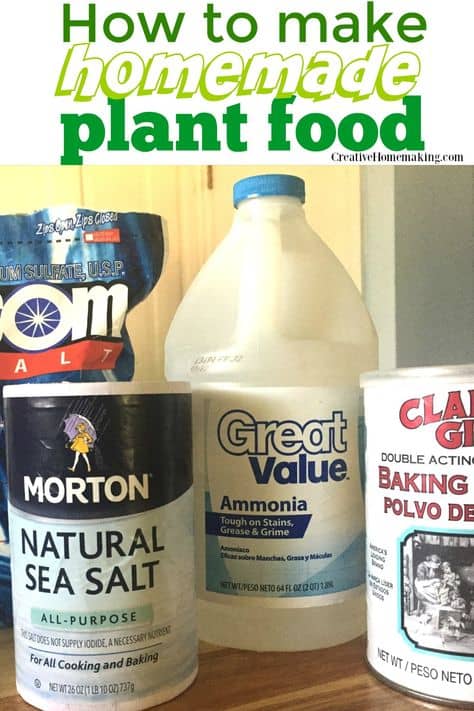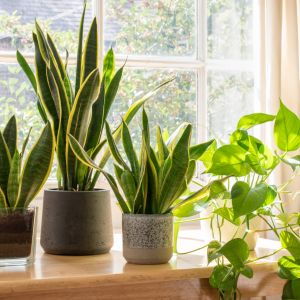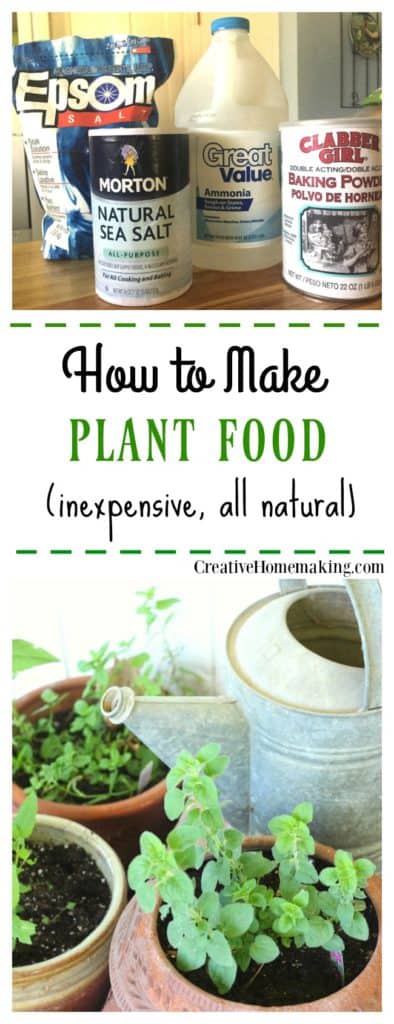Are you tired of spending money on expensive plant food that may or may not work? Well, why not try making your own homemade plant food? Not only is it cost-effective, but it’s also easy to make and can provide your plants with the nutrients they need to thrive.
This post may contain affiliate links.
There are many different recipes for homemade plant food. The ingredients you choose will depend on the type of plants you have and what nutrients they need. Some common ingredients include Epsom salt, baking powder, ammonia, and banana peels. By making your own plant food, you can control what goes into it and ensure that your plants are getting exactly what they need. Plus, it’s a great way to use up kitchen scraps and other household items that might otherwise go to waste.
Why Use Homemade Plant Food?
If you’re looking to keep your plants healthy and happy, you may be wondering whether you should use homemade plant food or store-bought plant food. While both options can provide your plants with the nutrients they need to thrive, there are several reasons why you may want to consider making your own plant food at home.
One of the biggest advantages of homemade plant food is that you have complete control over the ingredients that you use. Store-bought plant food often contains chemicals and synthetic ingredients that can be harmful to the environment and to your plants. By making your own plant food, you can use organic ingredients that are free from harmful chemicals and that are better for the environment.
Related Article: How to Use Banana Peels to Fertilize Houseplants
In addition, homemade plant food can be more cost-effective than store-bought options. While some organic ingredients may be more expensive upfront, you can often make larger batches of homemade plant food for a fraction of the cost of buying pre-made plant food.
Another benefit of making your own plant food is that you can tailor the nutrient content to the specific needs of your plants. Different plants require different nutrients in different amounts, and store-bought plant food may not provide the exact balance of nutrients that your plants need. By making your own plant food, you can adjust the nutrient content to meet the specific needs of your plants, ensuring that they get the nutrition they need to grow and thrive.
Ingredients for Homemade Plant Food
Making your own plant food is an excellent way to save money and provide your plants with the nutrients they need. You can use a variety of ingredients to create homemade plant food, from common household items to uncommon substances. In this section, we will explore the most common and uncommon ingredients used in homemade plant food.

Common Ingredients
Some of the most common ingredients used in homemade plant food include:
- Epsom salt: Epsom salt is a great source of magnesium and sulfur, two essential nutrients for plant growth. You can dissolve Epsom salt in water and use it as a foliar spray or soil drench.
- Coffee grounds: Coffee grounds are rich in nitrogen, phosphorus, and potassium, which makes them an excellent addition to your compost pile or soil.
- Manure: Manure is an excellent source of nitrogen and other nutrients. You can use cow, horse, or chicken manure in your plant food recipe.
- Eggshells: Eggshells are a good source of calcium, which is essential for plant growth. Crushed eggshells can be added to your compost pile or soil.
- Compost: Compost is a great source of micronutrients and organic matter. You can use compost tea or add compost directly to your soil.
Related Article: 6 Natural Fertilizers for Indoor Plants
Uncommon Ingredients
Some less common ingredients used in homemade plant food include:
- Baking soda: Baking soda can help raise the pH level of your soil, making it more alkaline. This can be helpful if your soil is too acidic.
- Green tea: Green tea is rich in antioxidants and can be used as a foliar spray to help protect your plants from pests and diseases.
- Gelatin: Gelatin is a good source of nitrogen and can be used to feed your plants. You can dissolve gelatin in water and use it as a soil drench.
- Aquarium water: Aquarium water is rich in nutrients and can be used to water your plants. The fish waste in the water provides nitrogen and other essential nutrients.
- Bone meal: Bone meal is a good source of phosphorus and can be used to help promote root growth. You can add bone meal to your soil or use it as a foliar spray.
Some ingredients, such as bleach or hydrogen peroxide, can be harmful to your plants and should be used with caution. Always research the ingredients you plan to use and their effects on plants before creating your homemade plant food.
Related Article: Best Organic Houseplant Fertilizers
Recipes for Homemade Plant Food
If you want to keep your plants healthy and thriving, homemade plant food recipes can help. Whether you have indoor or outdoor plants, there are many different options for creating your own plant food at home. Here are some general recipe tips and specific recipes for both types of plants.
General Recipe Tips
Here are a few general tips to keep in mind when making your own plant food:
- Use high-quality ingredients: The quality of your ingredients will directly impact the health of your plants. Use fresh, organic ingredients whenever possible.
- Balance nutrients: Plants need a balance of nutrients to grow strong and healthy. Make sure your homemade plant food includes a mix of nitrogen, phosphorus, and potassium.
- Use caution with manure: While manure can be a great source of nutrients for plants, it can also contain harmful bacteria. If you choose to use manure, make sure it has been properly composted before using it in your plant food.

Recipes for Outdoor Plants
For outdoor plants, there are many different homemade plant food recipes you can try. Here are a few options to get you started:
- Epsom Salt Fertilizer: Mix 1 tablespoon of Epsom salt with 1 gallon of water and use it to water your plants every other week. This will provide a boost of magnesium, which is essential for healthy plant growth.
- Manure Tea: Steep a handful of well-composted manure in a bucket of water for several days. Strain out the solids and use the liquid to water your plants. This will provide a rich source of nutrients for your plants.
- Fish Emulsion Fertilizer: Mix 1 tablespoon of fish emulsion with 1 gallon of water and use it to water your plants every two weeks. This will provide a boost of nitrogen, which is essential for healthy plant growth.
Related Article: Using Epsom Salt to Fertilize Houseplants
Recipes for Indoor Plants
For indoor plants, there are also many different homemade plant food recipes you can try. Here are a few options to get you started:
- Coffee Ground Fertilizer: Mix 1 tablespoon of used coffee grounds with 1 gallon of water and use it to water your plants every other week. This will provide a boost of nitrogen and other nutrients.
- Banana Peel Fertilizer: Place a banana peel in a jar and cover it with water. Let it sit for several days, then strain out the liquid and use it to water your plants. This will provide a rich source of potassium, which is essential for healthy plant growth.
- Eggshell Fertilizer: Crush up eggshells and sprinkle them on the soil around your plants. This will provide a boost of calcium, which is essential for healthy plant growth.
Related Article: Homemade African Violet Fertilizer
By making your own plant food, you can save money and ensure that your plants are getting the nutrients they need to thrive. While store-bought fertilizers can be effective, homemade plant food recipes can be just as effective, if not more so.
How to Use Homemade Plant Food
If you have made your own plant food, you might be wondering how to use it. Here are some tips on how to apply it to your plants and how often to use it.
Application Methods
The application method you choose will depend on the type of plant you have and its growing conditions. Here are some common methods:
- Watering: One of the easiest ways to apply homemade plant food is by mixing it with water. You can add the plant food to your watering can and water your plants as you normally would. This is a good method for potted plants and houseplants.
- Foliar Spray: For plants that absorb nutrients through their leaves, you can make a foliar spray by mixing the plant food with water and spraying it on the leaves. This is a good method for hydrangeas and roses.
- Soil Application: You can also apply the plant food directly to the soil around your plants. This is a good method for vegetable gardens and flowering plants.
Frequency of Use
How often you use homemade plant food will depend on the type of plant you have and its growing season. Here are some general guidelines:
- Growing Season: During the growing season, you can use homemade plant food every two to three weeks to help your plants grow strong and healthy.
- Off-Season: During the off-season, you can reduce the frequency of use to once a month or less.
- Photosynthesis: Keep in mind that plants need sunlight to perform photosynthesis, which is how they create energy from the nutrients in the soil. So, make sure your plants are getting enough sunlight, in addition to the homemade plant food.
Benefits of Homemade Plant Food
Making your own plant food has a lot of benefits that you can’t get from store-bought products. Here are some of the benefits of homemade plant food.
Nutrition and Growth
Homemade plant food can provide the necessary nutrients that your plants need for healthy growth. When you make your own plant food, you can customize the nutrients to meet the specific needs of your plants. For example, some plants require more nitrogen than others, so you can adjust the recipe to provide the right balance of nutrients. Homemade plant food can also help your plants grow faster and produce more flowers or fruits.
Disease Prevention
Fungal diseases are a common problem for plants, especially when they are overwatered. Homemade plant food can help prevent fungal diseases by providing the right balance of nutrients and reducing the risk of overwatering. Household ammonia is a common ingredient in homemade plant food that can help prevent fungal diseases. The scent of ammonia can also help keep pests away from your plants.
Cost Savings
Making your own plant food can save you a lot of money in the long run. Store-bought plant food can be expensive, and you may need to buy different products for different plants. When you make your own plant food, you can use household items that you already have. Homemade plant food is also more eco-friendly than store-bought products, as it reduces waste and packaging.
Frequently Asked Questions
How do you make homemade liquid plant food?
To make homemade liquid plant food, you can use a variety of ingredients such as Epsom salt, coffee grounds, and fish tank water. One popular recipe involves mixing 1 tablespoon of Epsom salt, 1 teaspoon of baking powder, and 1/2 teaspoon of ammonia in a gallon of water. Mix well and use as needed.
Related Article: How to Get Rid of Gnats in House Plants
What is a good homemade fertilizer for flowering plants?
A good homemade fertilizer for flowering plants is one that is high in phosphorus. You can make a homemade fertilizer by mixing bone meal, Epsom salt, and water. Mix 1 tablespoon of bone meal and 1 tablespoon of Epsom salt in a gallon of water. Use this mixture to water your flowering plants every two weeks.
What are some alternatives to ammonia for plant food?
If you’re looking for alternatives to ammonia for plant food, you can try using compost tea, which is made by steeping compost in water. Another option is to use fish tank water, which is high in nutrients and can be used to water your plants.
Follow my gardening board on Pinterest.





I’m really glad someone can bring these solutions out I have a gnat problem in my plants so I will be using these solutions thank you.
Can i use ammonium phosphate instead of ammonia in this recipe? I use it for my spriulina medium, so have it on hand. I don’t have regular ammonia on hand. Thanks.
Dear sir my plants not grow properly and now get flower mostly hibiscus and rose plants. please tell me some solutions for this problem.
Permalink
Permalink
I love summer but I hate the bugs that get on my garden.